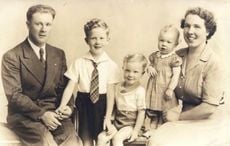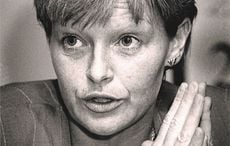| Election literature - Dick Spring |
Consider this submission for your approval: Unemployment so high it’s getting vertigo; a rickety, Fianna Fáil coalition led by a deeply unpopular midlander staring down the barrel of an unseemly end; a Fine Gael party bedevilled by their unfashionable leader; while Labour make unprecedented gains in the polls, absorbing disaffected independents from all directions and looking forward to enormous gains in constituencies were previously James Connolly himself would’ve struggled to get half a quota.
Yes folks, it’s 1992 all over again.
With the benefit of hindsight we now know that 1992 was the high water mark of misery in what had been an extended period of chastened economic woe, but from then on things got steadily better: unemployment went down, investment went up and, mirabile dictu, governments even ran budget surpluses.
As many great things happened in the years following ’92 as ruddy awful things happened in the last two years, awfulness precipitated by the astounding hubris of the notion that the past was another country, never to be re-visited. It wasn’t. But, as the indicators seem to be suggesting, the political gods are offering a second chance, a cosmic do-over of sorts. The parties would do well to make the most of it.
The party with the most to gain and the most to learn is undoubtedly Labour. After the election of November ’92, Dick Spring’s tide engulfed 33 seats in the Dáil chamber, over double what they’d had previously. But after election night things went downhill: Labour’s gain had been Fine Gael’s emphatic loss, and the two old coalition partners could only muster 78 between them, five shy of a Dáil majority. With Labour’s reluctance to bring the Progressive Democrats into the equation and John Bruton’s hostility toward the Democratic Left, Spring’s ambition of getting a turn as Taoiseach was looking bleak. So, Labour did the unthinkable and turned to Fianna Fáil, who were holding out hope they would and had studiously prepared for such an eventuality.
Fianna Fáil and Labour formed a government in January 1993 that was touted to last well into the next century but Labour and Spring, who had won said 33 seats on the premise of radical change and hoisting Fianna Fáil from office, paid a heavy price.
Pilloried in the media and trounced in subsequent by-elections, Labour readily jumped ship in December 1994 following the bungled extradition of the paedophile priest Brendan Smyth, and following a shift in the numbers game were able to form government with Fine Gael and the Democratic Left after all. While it was one of the more stable and successful governments the country has ever seen, the voters’ memory was sufficiently long to see Labour’s representation halved at the next election. Eamon Gilmore would do well to seek the counsel of Spring following the results of the next election. Or failing that, read Christopher Marlowe’s “Dr. Faustus”.
Fine Gael too have lessons to learn. It was patently clear from early on in his leadership of the party that Bruton was thoroughly unelectable as Taoiseach, and polls repeatedly had him miles behind the popularity of Dick Spring prior to the election. There were even suggestions that Bruton make way for a more palatable cross-party leader, suggestions he flatly rebuffed. All of this was compounded by his unilateral calls for coalition government without consulting his prospective partners and obstinate and haughty attitude to sharing power with the ex-Stickies in the Democratic Left, an attitude he’d have to shelve two years hence. Even when Labour went into government he couldn’t convert what should have been a slam dunk in terms of political point scores, and hobbled on as leader after an attempted heave in early 1994, demoting some talented dissenters in the process. That he found himself as Taoiseach at all was as much a surprise to him as anyone else. As it turns out, he was unelectable as Taoiseach, as his was the only government not formed following an election, and he failed to win a second term in 1997.
Enda Kenny’s story is remarkably similar to Bruton’s, if a bit more hapless and a bit less capable, and his zero-tolerance approach to working with Sinn Féin may be one he has to revisit if things don’t quite go the plan at the next election. If he’s still in charge by then.
For Fianna Fáil, the picture is a bit more bleak: the best they can hope for is control their damage for next time round and elect a conciliatory leader to replace Cowen, Micheal Martin would be ideal. But Fianna Fáil is the nation’s default setting and history has proven that if they keep quiet on the opposition benches for a while, pretend the last few years didn’t happen and elect a likeable leader, or at least someone difficult to hate, then all manner of sins will be forgiven. Fine Gael and Labour have to be much more careful. For the Greens, it’s bleaker still. Prayer can only do so much.
The next election, as it was in ’92, is an open goal for the opposition. If Labour maintain a principled stance at the point of impasse and if Fine Gael sort out their leadership woes before they encounter another round of stonewalling deals they’ll later rue or making lone runs they’re incapable of, they might just convert it this time. Whether all concerned do things differently once they’re in power next time around is much harder to predict.




Comments